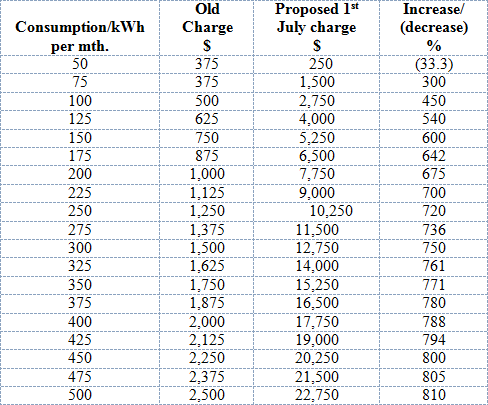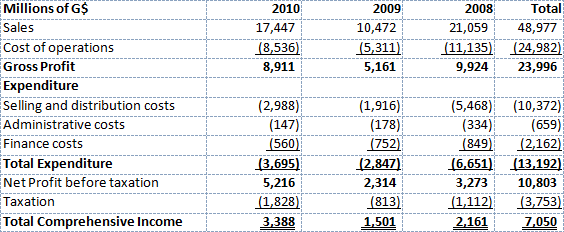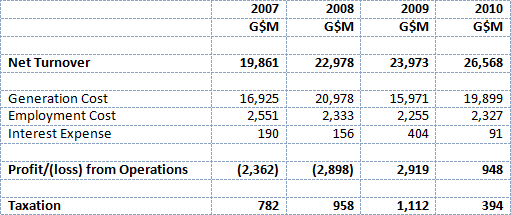It is hard to believe that GPL’s Chairman Brassington and CEO Bharat Dindyal do not understand the difference between the income statement and electricity rates and capital expenditure and cash flows. It is equally difficult to understand why they would mistake assertion for “insinuation” even describing it as a demonstration of “gross ignorance” (‘GPL denies scare tactics over cut of subsidies’ SN, April 25).
The Brassington-Dindyal statement deserves only a limited response while the letter by the company in other print media deserves none.
Not because of their absurdity or crudeness but to help contribute to an understanding why electricity consumers continue to pay exorbitant rates, why GPL is unable to manage and control expenditure, why a board of independent professionals is so important, why highly paid managers should produce equally high quality results and why their collective failure is making electricity unaffordable.
Messrs Brassington and Dindyal claim that GPL has “foregone revenues of over $27 billion to the end of this year.” They are either delusional or dishonest. The ESRA formula for rates is linked to performance targets, including substantial reduction in system losses by the former private investor. That investor abandoned the company in 2003 and its successor has not met the loss reduction targets. Any $27 billion of foregone revenue is therefore a mirage.
But if Messrs Brassington and Dindyal seriously believe GPL is entitled to the rate increase why do they not apply for and have consumers pay, rather than ask taxpayers to pay? Maybe they understand that with a more transparent rather than disguised tariff increase elasticity of demand would bite and more businesses would invest in their own generation plant. Or maybe they do not understand that the budget’s announcement to subsidise the light bills of pensioners is a realisation that tariffs are already too high for tens of thousands of Guyanese.
“So much for lack of progress,” smugly exude Messrs Brassington and Dindyal as they boast of their performance as top managers of system loss control.
This time, delusion or distortion. According to the company’s annual reports and information released at various PUC hearings, system losses under Brassington and Dindyal in the past six years were: 2007: 33.6%; 2008: 33.9%; 2009: 34.3%; 2010: 31.3%; 2011: 31.6%; and 2012: 31.7%. In other words, between 2010 and 2012 system losses increased despite capital expenditure estimated at over $20 billion or US$100 million during the same period.
And even if the duo prefer to measure the progress over five rather than the more recent three years, the improvement is 1.9% or 0.38% per year. My former boss Grenada Finance Minister Bernard Coard would probably be pleased that I am finally taking his advice.
Embarrassed at the exposure of the widespread super-salaries paid to GPL’s 29 management staff, Messrs Brassington and Dindyal seek comparison with the region. Would they point out a single regional utility that generates less than 20% of the electricity it has available for sale that produces as poor results as GPL does? Or which has a ratio of management compensation to total wages and salaries as GPL does?
Not only are the top personnel in GPL overpaid but they are increasingly so. In 2008 the percentage of key management compensation to total wages and salaries was 9.66%; in 2010 it rose to 12.55%! Incidentally among these highfliers is Mr Kumar Sharma, who is listed as a Loss Reduction Director. Would Mr Brassington describe as “ignorant” or “grossly ignorant” the suggestion that Messrs Dindyal and Sharma should have their salaries tied to performance and loss reduction?
But what about comparing the salaries of GPL’s managers with their peers in other local entities that are so better directed and managed? Here are some revealing statistics. According to their most recent annual reports, the top seven public companies in Guyana paid their entire key management team an average of $131 million for that year. In GPL for 2010 the comparable amount was $272 million, more than twice as much.
And using GBTI as GPL’s nearest comparator with 31 key management personnel versus GPL’s 29, we note that average monthly salary per key management staff member of GBTI is $451,481 per month but at GPL it is $782,600 per month, 73% higher.
Here are some other troubling numbers: GPL’s administration expenses in 2010 increased by a whopping 47% over 2009. And of the 626 GWh power generated in 2010, 501 GWh or 80.03% was produced not by GPL but by GuySuCo (60 GWh) and Wartsila (441 GWh). In other words, while GPL owns generating equipment it contracts out its generation and then buys it back to sell to consumers. It seems to me that if the company was engaged in generation, its performance would probably have been so much worse. This raises the question: what do all those high-paying managers do?
On accountability, Mr Brassington assures us that the 2012 audit report would be issued by the end of this month but says nothing about 2011. So I remind him of this and that a recent company Development Plan projects system losses of 20.8% by the end of 2014.
Finally, to get back to the initial point I raised in my letter that caused apoplexy in GPL. I have no doubt that the National Assembly would entertain a request by GPL of the $5.2 billion it withheld once the company produces a credible plan to use the money sensibly and efficiently.
The operations and management of GPL need to be subject to a thorough performance and efficiency audit before it is given any more public funds. No amount of spinning by Messrs Brassington and Dindyal will convince any informed and independent observer that GPL as presently set up and operated is not a massive waste and a burden on the consumers.




